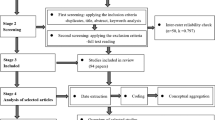Abstract
This paper investigates persuasion as a means of influence for the Federal Reserve Chairman in meetings of the Federal Open Market Committee (FOMC). Using textual records of FOMC meetings, federal funds rate targets have been recorded for Committee members who served in the Arthur Burns era (1970–1978). Results show that Burns-member differences in stated funds rate targets were lower when Burns made recommendations early in the meeting, consistent with the hypothesis that the Chairman is persuasive. Additional results show that members’ tendencies to respond to Burns's recommendations were related to their personal and political loyalties.
Similar content being viewed by others
References
Chappell, H.W. Jr., McGregor, R.R., & Vermilyea, T. (2004). Majority rule, consensus building, and the power of the Chairman: Arthur Burns and the FOMC. Journal of Money, Credit, and Banking, 36, 407–422.
Chappell, H.W. Jr., McGregor, R.R., & Vermilyea, T. (2005). Committee decisions on monetary policy: Evidence from historical records of the Federal Open Market Committee. Cambridge, MA: MIT Press.
Gilbert, K.S. (1992). Philip Chappell Jackson, Jr. In B.S. Katz (Ed.), Biographical dictionary of the Board of Governors of the Federal Reserve. Westport, CT: Greenwood Press.
Hakes, D.R. (1990). The objectives and priorities of monetary policy under different Federal Reserve Chairmen. Journal of Money, Credit, and Banking, 22, 327–337.
Havrilesky, T.M. (1995). The pressures on American monetary policy (2nd ed.). Norwell, MA: Kluwer Academic Publishers.
Jordan, J.L. (2001). Darryl Francis: Maverick in the formulation of monetary policy. Review (Federal Reserve Bank of St. Louis) 83(July/August), 17–22.
Kettl, D.F. (1986). Leadership at the Fed. New Haven, CT: Yale University Press.
Krause, G.A. (1994). Federal Reserve policy decision making: Political and bureaucratic influences. American Journal of Political Science, 38, 124–144.
Maisel, S.J. (1973). Managing the dollar. New York, NY: W.W. Norton and Company.
Peek, J., & Wilcox, J.A. (1987). Monetary policy regimes and the reduced form for interest rates. Journal of Money, Credit, and Banking, 19, 273–291.
Woolley, J. (1984). Monetary politics. New York, NY: Cambridge University Press.
Author information
Authors and Affiliations
Corresponding author
Additional information
JEL Codes: E58 – Central Banks and Their Policies
Rights and permissions
About this article
Cite this article
Chappell, H.W., McGregor, R.R. & Vermilyea, T. The persuasive power of a Committee Chairman: Arthur Burns and the FOMC. Public Choice 132, 103–112 (2007). https://doi.org/10.1007/s11127-006-9136-7
Received:
Accepted:
Published:
Issue Date:
DOI: https://doi.org/10.1007/s11127-006-9136-7




